Comprehensive Business Strategy Report: Tesco's Market Position
VerifiedAdded on 2023/06/18
|15
|4158
|295
Report
AI Summary
This report provides a comprehensive analysis of Tesco's business strategy, examining both the macro and internal environments that influence its operations. The PESTLE framework is used to assess political, economic, social, technological, legal, and environmental factors affecting Tesco, including the impact of Brexit and the COVID-19 pandemic. A SWOT analysis identifies Tesco's strengths, weaknesses, opportunities, and threats, such as its market leadership in the UK, challenges in the US and Japanese markets, and competition from other supermarket chains. The VRIO framework evaluates Tesco's resources and capabilities, while Porter's Five Forces model assesses the competitive forces within the retailing industry, including the bargaining power of buyers and suppliers, the threat of new entrants and substitutes, and the intensity of competitive rivalry. The report concludes with an evaluation of strategic planning for Tesco, offering insights into how the company can leverage its strengths and address its weaknesses to maintain a competitive advantage.
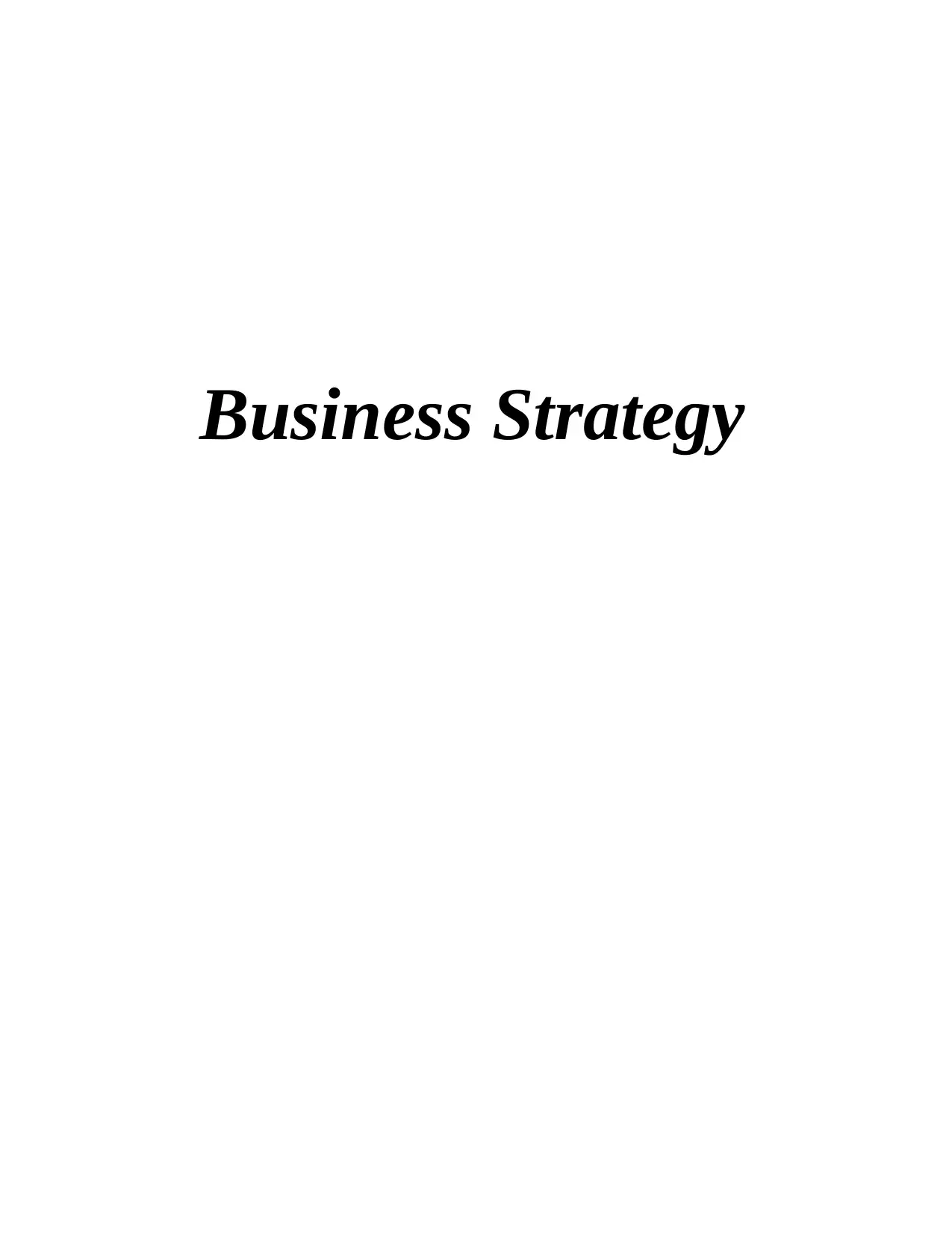
Business Strategy
Paraphrase This Document
Need a fresh take? Get an instant paraphrase of this document with our AI Paraphraser
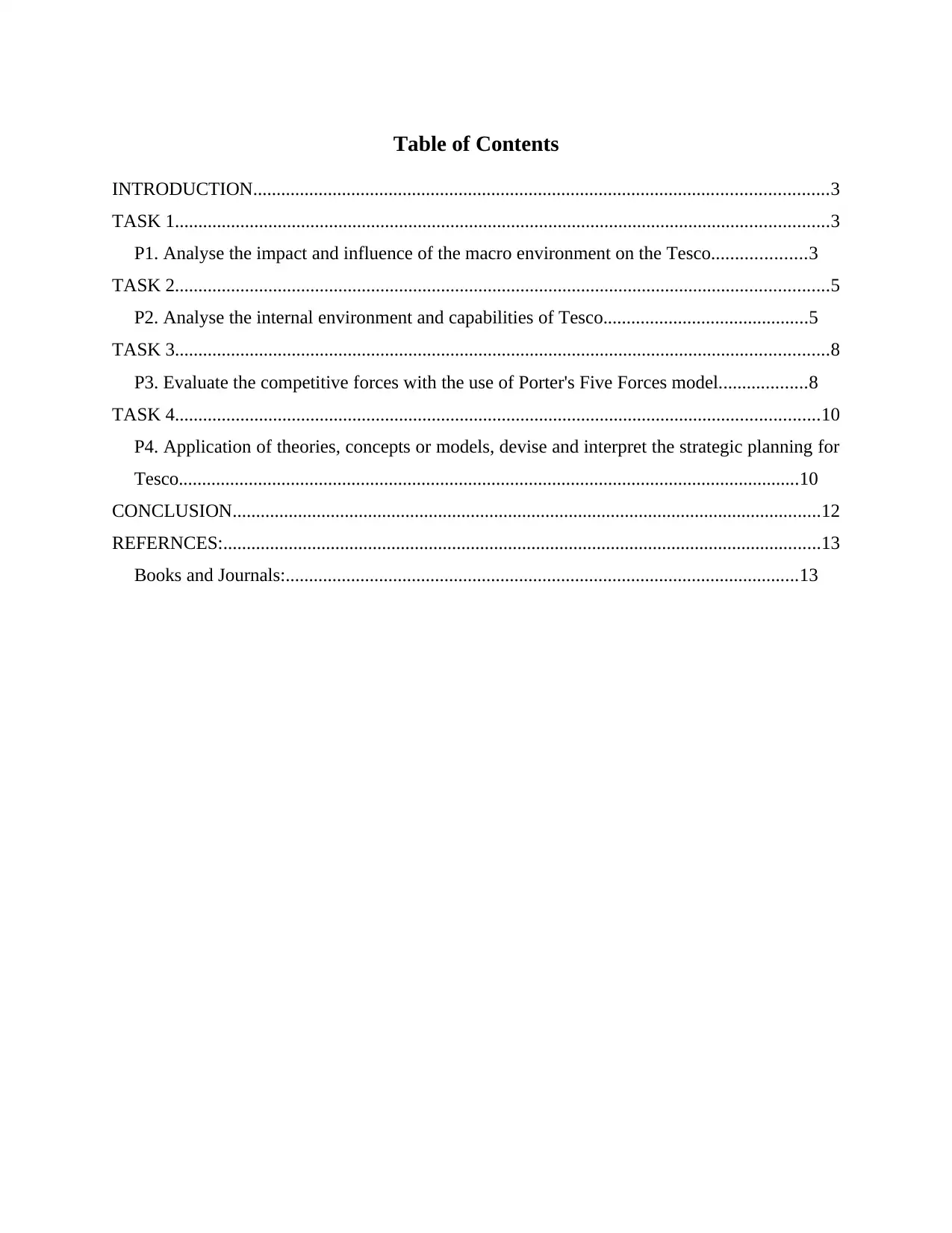
Table of Contents
INTRODUCTION...........................................................................................................................3
TASK 1............................................................................................................................................3
P1. Analyse the impact and influence of the macro environment on the Tesco....................3
TASK 2............................................................................................................................................5
P2. Analyse the internal environment and capabilities of Tesco............................................5
TASK 3............................................................................................................................................8
P3. Evaluate the competitive forces with the use of Porter's Five Forces model...................8
TASK 4..........................................................................................................................................10
P4. Application of theories, concepts or models, devise and interpret the strategic planning for
Tesco.....................................................................................................................................10
CONCLUSION..............................................................................................................................12
REFERNCES:................................................................................................................................13
Books and Journals:..............................................................................................................13
INTRODUCTION...........................................................................................................................3
TASK 1............................................................................................................................................3
P1. Analyse the impact and influence of the macro environment on the Tesco....................3
TASK 2............................................................................................................................................5
P2. Analyse the internal environment and capabilities of Tesco............................................5
TASK 3............................................................................................................................................8
P3. Evaluate the competitive forces with the use of Porter's Five Forces model...................8
TASK 4..........................................................................................................................................10
P4. Application of theories, concepts or models, devise and interpret the strategic planning for
Tesco.....................................................................................................................................10
CONCLUSION..............................................................................................................................12
REFERNCES:................................................................................................................................13
Books and Journals:..............................................................................................................13
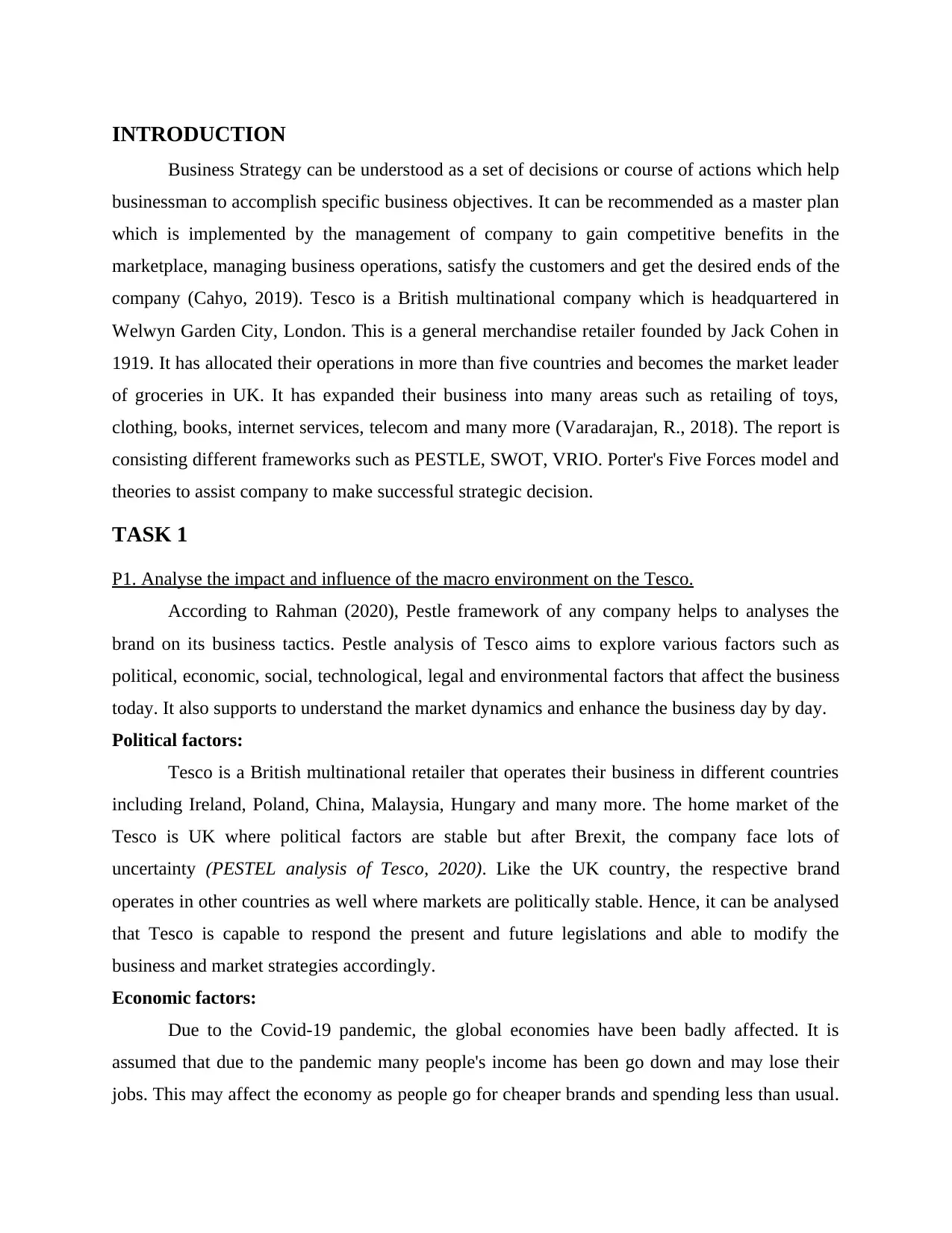
INTRODUCTION
Business Strategy can be understood as a set of decisions or course of actions which help
businessman to accomplish specific business objectives. It can be recommended as a master plan
which is implemented by the management of company to gain competitive benefits in the
marketplace, managing business operations, satisfy the customers and get the desired ends of the
company (Cahyo, 2019). Tesco is a British multinational company which is headquartered in
Welwyn Garden City, London. This is a general merchandise retailer founded by Jack Cohen in
1919. It has allocated their operations in more than five countries and becomes the market leader
of groceries in UK. It has expanded their business into many areas such as retailing of toys,
clothing, books, internet services, telecom and many more (Varadarajan, R., 2018). The report is
consisting different frameworks such as PESTLE, SWOT, VRIO. Porter's Five Forces model and
theories to assist company to make successful strategic decision.
TASK 1
P1. Analyse the impact and influence of the macro environment on the Tesco.
According to Rahman (2020), Pestle framework of any company helps to analyses the
brand on its business tactics. Pestle analysis of Tesco aims to explore various factors such as
political, economic, social, technological, legal and environmental factors that affect the business
today. It also supports to understand the market dynamics and enhance the business day by day.
Political factors:
Tesco is a British multinational retailer that operates their business in different countries
including Ireland, Poland, China, Malaysia, Hungary and many more. The home market of the
Tesco is UK where political factors are stable but after Brexit, the company face lots of
uncertainty (PESTEL analysis of Tesco, 2020). Like the UK country, the respective brand
operates in other countries as well where markets are politically stable. Hence, it can be analysed
that Tesco is capable to respond the present and future legislations and able to modify the
business and market strategies accordingly.
Economic factors:
Due to the Covid-19 pandemic, the global economies have been badly affected. It is
assumed that due to the pandemic many people's income has been go down and may lose their
jobs. This may affect the economy as people go for cheaper brands and spending less than usual.
Business Strategy can be understood as a set of decisions or course of actions which help
businessman to accomplish specific business objectives. It can be recommended as a master plan
which is implemented by the management of company to gain competitive benefits in the
marketplace, managing business operations, satisfy the customers and get the desired ends of the
company (Cahyo, 2019). Tesco is a British multinational company which is headquartered in
Welwyn Garden City, London. This is a general merchandise retailer founded by Jack Cohen in
1919. It has allocated their operations in more than five countries and becomes the market leader
of groceries in UK. It has expanded their business into many areas such as retailing of toys,
clothing, books, internet services, telecom and many more (Varadarajan, R., 2018). The report is
consisting different frameworks such as PESTLE, SWOT, VRIO. Porter's Five Forces model and
theories to assist company to make successful strategic decision.
TASK 1
P1. Analyse the impact and influence of the macro environment on the Tesco.
According to Rahman (2020), Pestle framework of any company helps to analyses the
brand on its business tactics. Pestle analysis of Tesco aims to explore various factors such as
political, economic, social, technological, legal and environmental factors that affect the business
today. It also supports to understand the market dynamics and enhance the business day by day.
Political factors:
Tesco is a British multinational retailer that operates their business in different countries
including Ireland, Poland, China, Malaysia, Hungary and many more. The home market of the
Tesco is UK where political factors are stable but after Brexit, the company face lots of
uncertainty (PESTEL analysis of Tesco, 2020). Like the UK country, the respective brand
operates in other countries as well where markets are politically stable. Hence, it can be analysed
that Tesco is capable to respond the present and future legislations and able to modify the
business and market strategies accordingly.
Economic factors:
Due to the Covid-19 pandemic, the global economies have been badly affected. It is
assumed that due to the pandemic many people's income has been go down and may lose their
jobs. This may affect the economy as people go for cheaper brands and spending less than usual.
⊘ This is a preview!⊘
Do you want full access?
Subscribe today to unlock all pages.

Trusted by 1+ million students worldwide
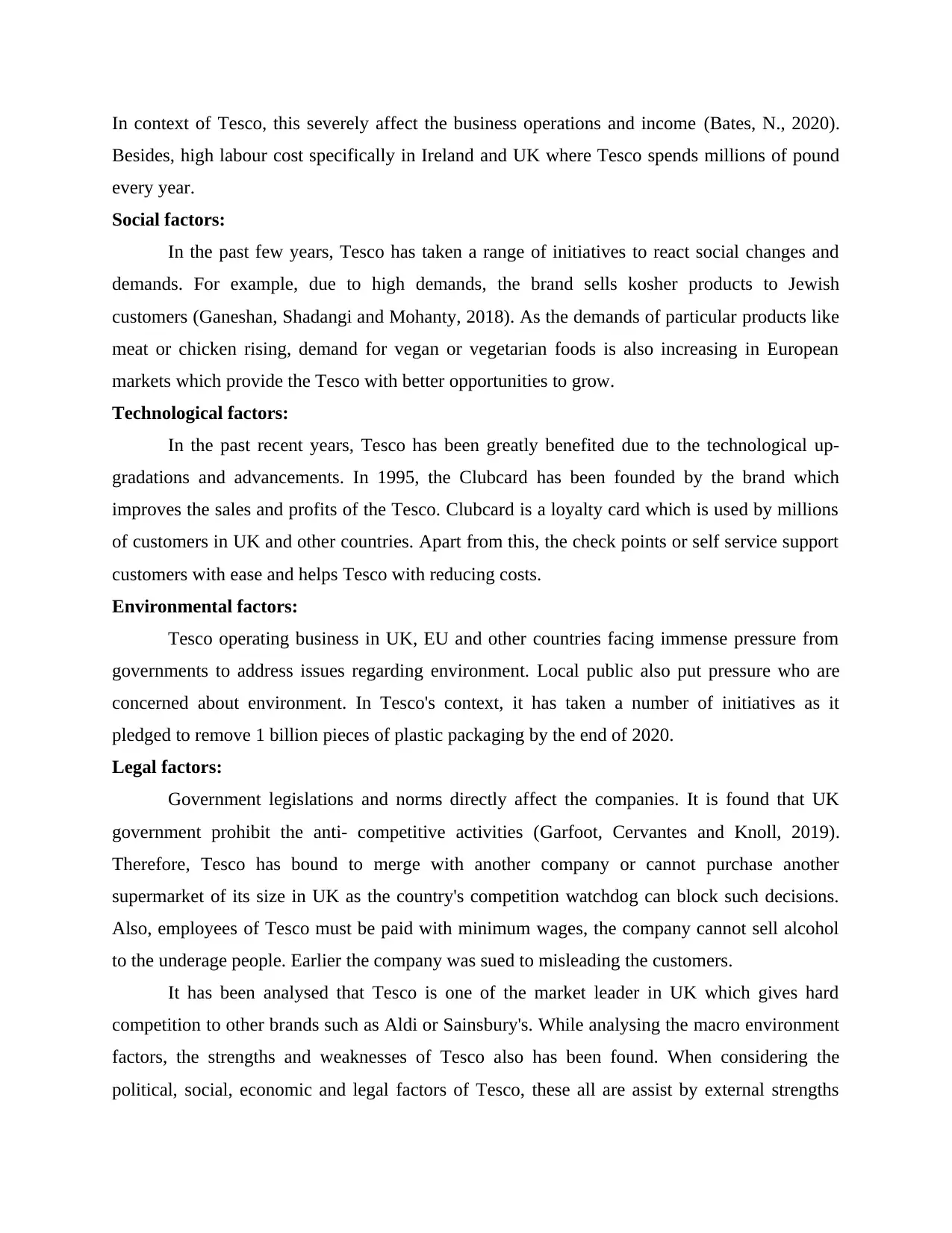
In context of Tesco, this severely affect the business operations and income (Bates, N., 2020).
Besides, high labour cost specifically in Ireland and UK where Tesco spends millions of pound
every year.
Social factors:
In the past few years, Tesco has taken a range of initiatives to react social changes and
demands. For example, due to high demands, the brand sells kosher products to Jewish
customers (Ganeshan, Shadangi and Mohanty, 2018). As the demands of particular products like
meat or chicken rising, demand for vegan or vegetarian foods is also increasing in European
markets which provide the Tesco with better opportunities to grow.
Technological factors:
In the past recent years, Tesco has been greatly benefited due to the technological up-
gradations and advancements. In 1995, the Clubcard has been founded by the brand which
improves the sales and profits of the Tesco. Clubcard is a loyalty card which is used by millions
of customers in UK and other countries. Apart from this, the check points or self service support
customers with ease and helps Tesco with reducing costs.
Environmental factors:
Tesco operating business in UK, EU and other countries facing immense pressure from
governments to address issues regarding environment. Local public also put pressure who are
concerned about environment. In Tesco's context, it has taken a number of initiatives as it
pledged to remove 1 billion pieces of plastic packaging by the end of 2020.
Legal factors:
Government legislations and norms directly affect the companies. It is found that UK
government prohibit the anti- competitive activities (Garfoot, Cervantes and Knoll, 2019).
Therefore, Tesco has bound to merge with another company or cannot purchase another
supermarket of its size in UK as the country's competition watchdog can block such decisions.
Also, employees of Tesco must be paid with minimum wages, the company cannot sell alcohol
to the underage people. Earlier the company was sued to misleading the customers.
It has been analysed that Tesco is one of the market leader in UK which gives hard
competition to other brands such as Aldi or Sainsbury's. While analysing the macro environment
factors, the strengths and weaknesses of Tesco also has been found. When considering the
political, social, economic and legal factors of Tesco, these all are assist by external strengths
Besides, high labour cost specifically in Ireland and UK where Tesco spends millions of pound
every year.
Social factors:
In the past few years, Tesco has taken a range of initiatives to react social changes and
demands. For example, due to high demands, the brand sells kosher products to Jewish
customers (Ganeshan, Shadangi and Mohanty, 2018). As the demands of particular products like
meat or chicken rising, demand for vegan or vegetarian foods is also increasing in European
markets which provide the Tesco with better opportunities to grow.
Technological factors:
In the past recent years, Tesco has been greatly benefited due to the technological up-
gradations and advancements. In 1995, the Clubcard has been founded by the brand which
improves the sales and profits of the Tesco. Clubcard is a loyalty card which is used by millions
of customers in UK and other countries. Apart from this, the check points or self service support
customers with ease and helps Tesco with reducing costs.
Environmental factors:
Tesco operating business in UK, EU and other countries facing immense pressure from
governments to address issues regarding environment. Local public also put pressure who are
concerned about environment. In Tesco's context, it has taken a number of initiatives as it
pledged to remove 1 billion pieces of plastic packaging by the end of 2020.
Legal factors:
Government legislations and norms directly affect the companies. It is found that UK
government prohibit the anti- competitive activities (Garfoot, Cervantes and Knoll, 2019).
Therefore, Tesco has bound to merge with another company or cannot purchase another
supermarket of its size in UK as the country's competition watchdog can block such decisions.
Also, employees of Tesco must be paid with minimum wages, the company cannot sell alcohol
to the underage people. Earlier the company was sued to misleading the customers.
It has been analysed that Tesco is one of the market leader in UK which gives hard
competition to other brands such as Aldi or Sainsbury's. While analysing the macro environment
factors, the strengths and weaknesses of Tesco also has been found. When considering the
political, social, economic and legal factors of Tesco, these all are assist by external strengths
Paraphrase This Document
Need a fresh take? Get an instant paraphrase of this document with our AI Paraphraser
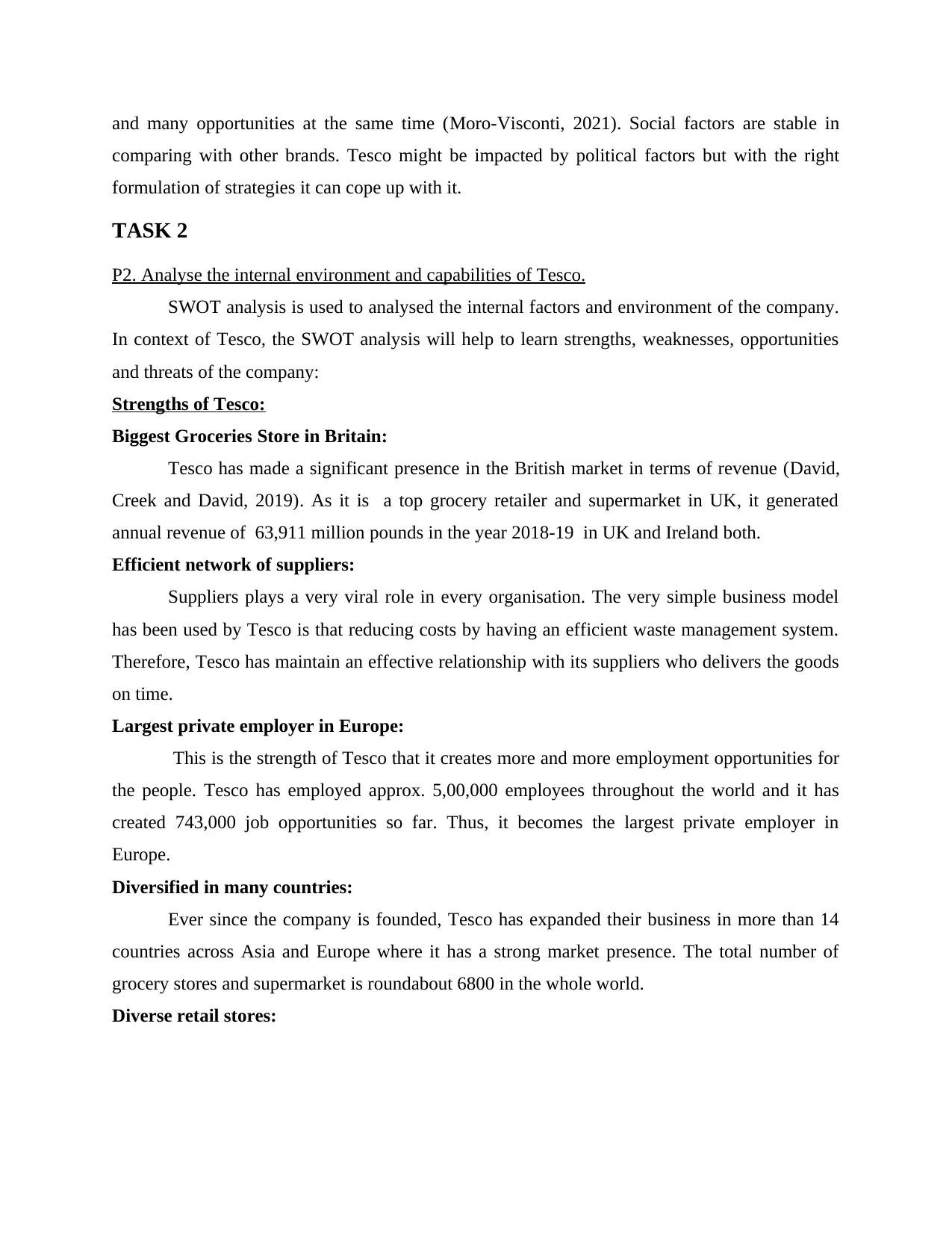
and many opportunities at the same time (Moro-Visconti, 2021). Social factors are stable in
comparing with other brands. Tesco might be impacted by political factors but with the right
formulation of strategies it can cope up with it.
TASK 2
P2. Analyse the internal environment and capabilities of Tesco.
SWOT analysis is used to analysed the internal factors and environment of the company.
In context of Tesco, the SWOT analysis will help to learn strengths, weaknesses, opportunities
and threats of the company:
Strengths of Tesco:
Biggest Groceries Store in Britain:
Tesco has made a significant presence in the British market in terms of revenue (David,
Creek and David, 2019). As it is a top grocery retailer and supermarket in UK, it generated
annual revenue of 63,911 million pounds in the year 2018-19 in UK and Ireland both.
Efficient network of suppliers:
Suppliers plays a very viral role in every organisation. The very simple business model
has been used by Tesco is that reducing costs by having an efficient waste management system.
Therefore, Tesco has maintain an effective relationship with its suppliers who delivers the goods
on time.
Largest private employer in Europe:
This is the strength of Tesco that it creates more and more employment opportunities for
the people. Tesco has employed approx. 5,00,000 employees throughout the world and it has
created 743,000 job opportunities so far. Thus, it becomes the largest private employer in
Europe.
Diversified in many countries:
Ever since the company is founded, Tesco has expanded their business in more than 14
countries across Asia and Europe where it has a strong market presence. The total number of
grocery stores and supermarket is roundabout 6800 in the whole world.
Diverse retail stores:
comparing with other brands. Tesco might be impacted by political factors but with the right
formulation of strategies it can cope up with it.
TASK 2
P2. Analyse the internal environment and capabilities of Tesco.
SWOT analysis is used to analysed the internal factors and environment of the company.
In context of Tesco, the SWOT analysis will help to learn strengths, weaknesses, opportunities
and threats of the company:
Strengths of Tesco:
Biggest Groceries Store in Britain:
Tesco has made a significant presence in the British market in terms of revenue (David,
Creek and David, 2019). As it is a top grocery retailer and supermarket in UK, it generated
annual revenue of 63,911 million pounds in the year 2018-19 in UK and Ireland both.
Efficient network of suppliers:
Suppliers plays a very viral role in every organisation. The very simple business model
has been used by Tesco is that reducing costs by having an efficient waste management system.
Therefore, Tesco has maintain an effective relationship with its suppliers who delivers the goods
on time.
Largest private employer in Europe:
This is the strength of Tesco that it creates more and more employment opportunities for
the people. Tesco has employed approx. 5,00,000 employees throughout the world and it has
created 743,000 job opportunities so far. Thus, it becomes the largest private employer in
Europe.
Diversified in many countries:
Ever since the company is founded, Tesco has expanded their business in more than 14
countries across Asia and Europe where it has a strong market presence. The total number of
grocery stores and supermarket is roundabout 6800 in the whole world.
Diverse retail stores:
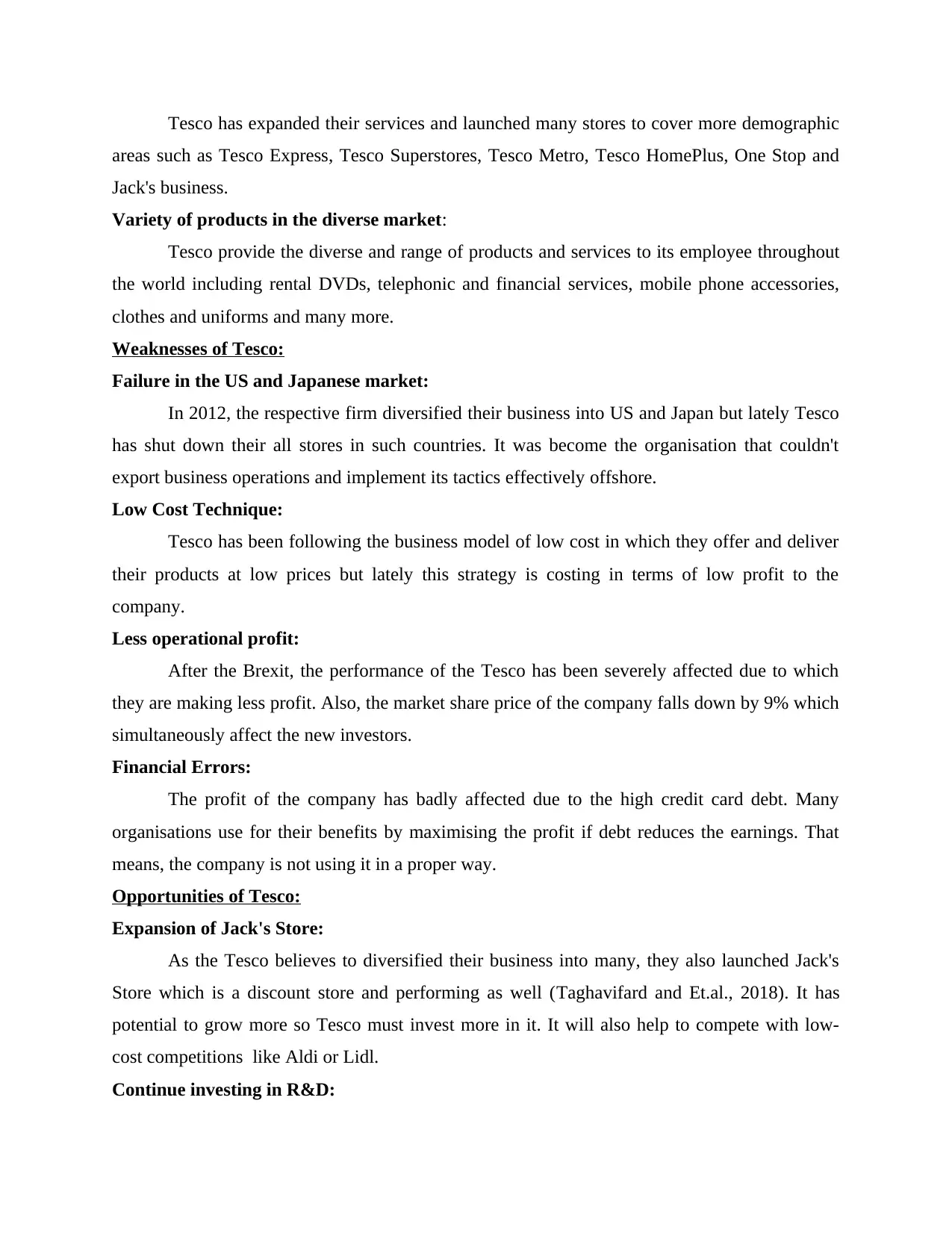
Tesco has expanded their services and launched many stores to cover more demographic
areas such as Tesco Express, Tesco Superstores, Tesco Metro, Tesco HomePlus, One Stop and
Jack's business.
Variety of products in the diverse market:
Tesco provide the diverse and range of products and services to its employee throughout
the world including rental DVDs, telephonic and financial services, mobile phone accessories,
clothes and uniforms and many more.
Weaknesses of Tesco:
Failure in the US and Japanese market:
In 2012, the respective firm diversified their business into US and Japan but lately Tesco
has shut down their all stores in such countries. It was become the organisation that couldn't
export business operations and implement its tactics effectively offshore.
Low Cost Technique:
Tesco has been following the business model of low cost in which they offer and deliver
their products at low prices but lately this strategy is costing in terms of low profit to the
company.
Less operational profit:
After the Brexit, the performance of the Tesco has been severely affected due to which
they are making less profit. Also, the market share price of the company falls down by 9% which
simultaneously affect the new investors.
Financial Errors:
The profit of the company has badly affected due to the high credit card debt. Many
organisations use for their benefits by maximising the profit if debt reduces the earnings. That
means, the company is not using it in a proper way.
Opportunities of Tesco:
Expansion of Jack's Store:
As the Tesco believes to diversified their business into many, they also launched Jack's
Store which is a discount store and performing as well (Taghavifard and Et.al., 2018). It has
potential to grow more so Tesco must invest more in it. It will also help to compete with low-
cost competitions like Aldi or Lidl.
Continue investing in R&D:
areas such as Tesco Express, Tesco Superstores, Tesco Metro, Tesco HomePlus, One Stop and
Jack's business.
Variety of products in the diverse market:
Tesco provide the diverse and range of products and services to its employee throughout
the world including rental DVDs, telephonic and financial services, mobile phone accessories,
clothes and uniforms and many more.
Weaknesses of Tesco:
Failure in the US and Japanese market:
In 2012, the respective firm diversified their business into US and Japan but lately Tesco
has shut down their all stores in such countries. It was become the organisation that couldn't
export business operations and implement its tactics effectively offshore.
Low Cost Technique:
Tesco has been following the business model of low cost in which they offer and deliver
their products at low prices but lately this strategy is costing in terms of low profit to the
company.
Less operational profit:
After the Brexit, the performance of the Tesco has been severely affected due to which
they are making less profit. Also, the market share price of the company falls down by 9% which
simultaneously affect the new investors.
Financial Errors:
The profit of the company has badly affected due to the high credit card debt. Many
organisations use for their benefits by maximising the profit if debt reduces the earnings. That
means, the company is not using it in a proper way.
Opportunities of Tesco:
Expansion of Jack's Store:
As the Tesco believes to diversified their business into many, they also launched Jack's
Store which is a discount store and performing as well (Taghavifard and Et.al., 2018). It has
potential to grow more so Tesco must invest more in it. It will also help to compete with low-
cost competitions like Aldi or Lidl.
Continue investing in R&D:
⊘ This is a preview!⊘
Do you want full access?
Subscribe today to unlock all pages.

Trusted by 1+ million students worldwide
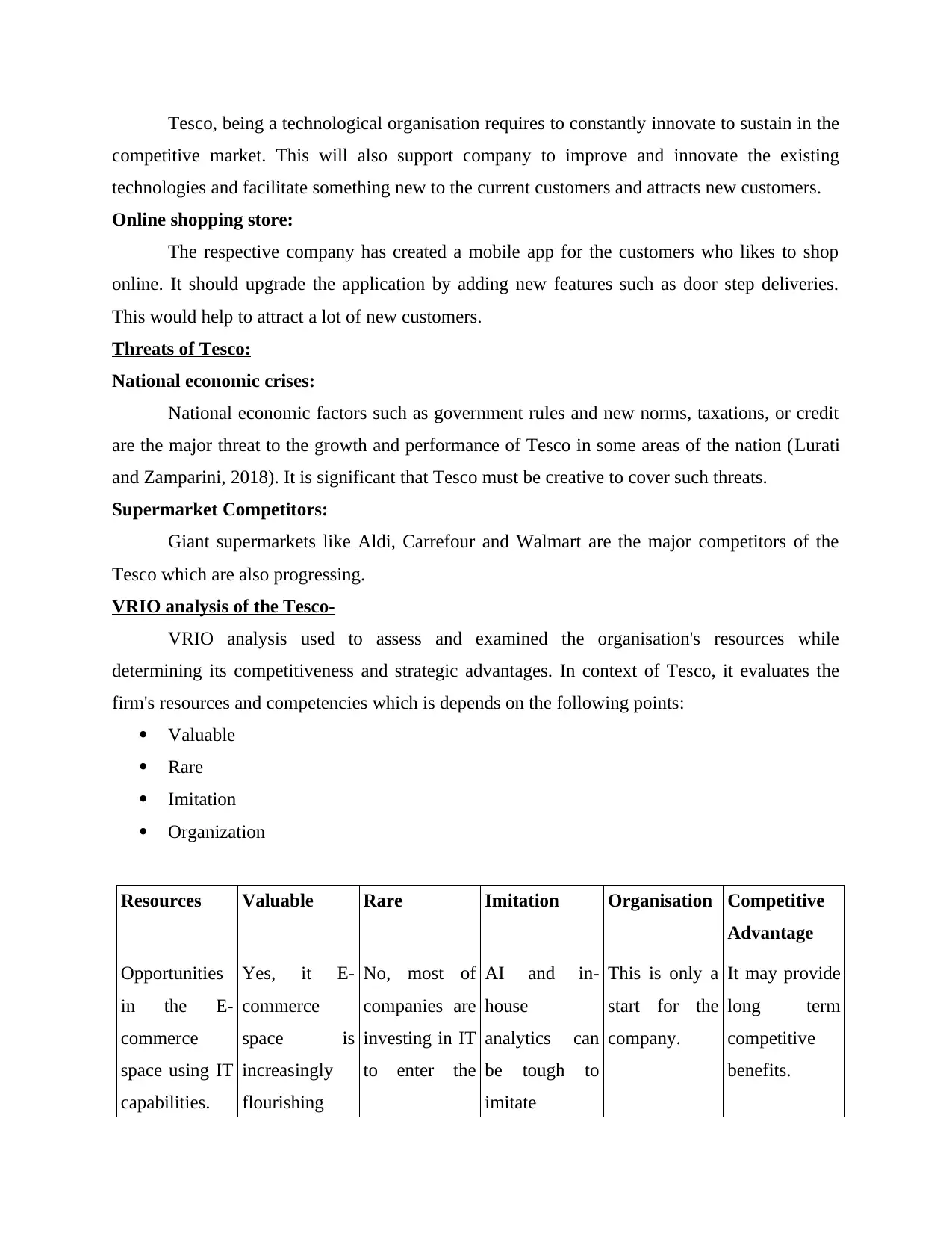
Tesco, being a technological organisation requires to constantly innovate to sustain in the
competitive market. This will also support company to improve and innovate the existing
technologies and facilitate something new to the current customers and attracts new customers.
Online shopping store:
The respective company has created a mobile app for the customers who likes to shop
online. It should upgrade the application by adding new features such as door step deliveries.
This would help to attract a lot of new customers.
Threats of Tesco:
National economic crises:
National economic factors such as government rules and new norms, taxations, or credit
are the major threat to the growth and performance of Tesco in some areas of the nation (Lurati
and Zamparini, 2018). It is significant that Tesco must be creative to cover such threats.
Supermarket Competitors:
Giant supermarkets like Aldi, Carrefour and Walmart are the major competitors of the
Tesco which are also progressing.
VRIO analysis of the Tesco-
VRIO analysis used to assess and examined the organisation's resources while
determining its competitiveness and strategic advantages. In context of Tesco, it evaluates the
firm's resources and competencies which is depends on the following points:
Valuable
Rare
Imitation
Organization
Resources Valuable Rare Imitation Organisation Competitive
Advantage
Opportunities
in the E-
commerce
space using IT
capabilities.
Yes, it E-
commerce
space is
increasingly
flourishing
No, most of
companies are
investing in IT
to enter the
AI and in-
house
analytics can
be tough to
imitate
This is only a
start for the
company.
It may provide
long term
competitive
benefits.
competitive market. This will also support company to improve and innovate the existing
technologies and facilitate something new to the current customers and attracts new customers.
Online shopping store:
The respective company has created a mobile app for the customers who likes to shop
online. It should upgrade the application by adding new features such as door step deliveries.
This would help to attract a lot of new customers.
Threats of Tesco:
National economic crises:
National economic factors such as government rules and new norms, taxations, or credit
are the major threat to the growth and performance of Tesco in some areas of the nation (Lurati
and Zamparini, 2018). It is significant that Tesco must be creative to cover such threats.
Supermarket Competitors:
Giant supermarkets like Aldi, Carrefour and Walmart are the major competitors of the
Tesco which are also progressing.
VRIO analysis of the Tesco-
VRIO analysis used to assess and examined the organisation's resources while
determining its competitiveness and strategic advantages. In context of Tesco, it evaluates the
firm's resources and competencies which is depends on the following points:
Valuable
Rare
Imitation
Organization
Resources Valuable Rare Imitation Organisation Competitive
Advantage
Opportunities
in the E-
commerce
space using IT
capabilities.
Yes, it E-
commerce
space is
increasingly
flourishing
No, most of
companies are
investing in IT
to enter the
AI and in-
house
analytics can
be tough to
imitate
This is only a
start for the
company.
It may provide
long term
competitive
benefits.
Paraphrase This Document
Need a fresh take? Get an instant paraphrase of this document with our AI Paraphraser
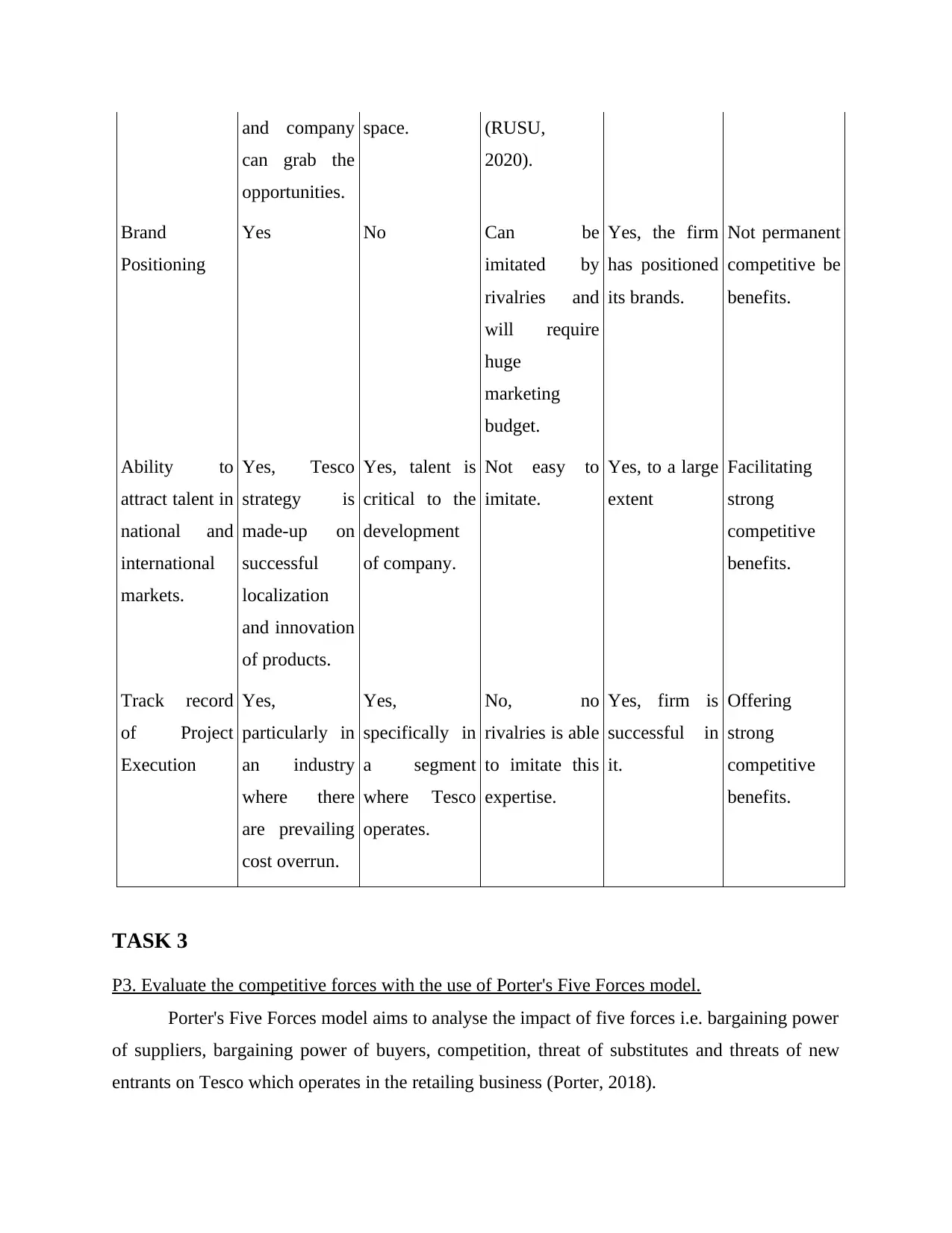
and company
can grab the
opportunities.
space. (RUSU,
2020).
Brand
Positioning
Yes No Can be
imitated by
rivalries and
will require
huge
marketing
budget.
Yes, the firm
has positioned
its brands.
Not permanent
competitive be
benefits.
Ability to
attract talent in
national and
international
markets.
Yes, Tesco
strategy is
made-up on
successful
localization
and innovation
of products.
Yes, talent is
critical to the
development
of company.
Not easy to
imitate.
Yes, to a large
extent
Facilitating
strong
competitive
benefits.
Track record
of Project
Execution
Yes,
particularly in
an industry
where there
are prevailing
cost overrun.
Yes,
specifically in
a segment
where Tesco
operates.
No, no
rivalries is able
to imitate this
expertise.
Yes, firm is
successful in
it.
Offering
strong
competitive
benefits.
TASK 3
P3. Evaluate the competitive forces with the use of Porter's Five Forces model.
Porter's Five Forces model aims to analyse the impact of five forces i.e. bargaining power
of suppliers, bargaining power of buyers, competition, threat of substitutes and threats of new
entrants on Tesco which operates in the retailing business (Porter, 2018).
can grab the
opportunities.
space. (RUSU,
2020).
Brand
Positioning
Yes No Can be
imitated by
rivalries and
will require
huge
marketing
budget.
Yes, the firm
has positioned
its brands.
Not permanent
competitive be
benefits.
Ability to
attract talent in
national and
international
markets.
Yes, Tesco
strategy is
made-up on
successful
localization
and innovation
of products.
Yes, talent is
critical to the
development
of company.
Not easy to
imitate.
Yes, to a large
extent
Facilitating
strong
competitive
benefits.
Track record
of Project
Execution
Yes,
particularly in
an industry
where there
are prevailing
cost overrun.
Yes,
specifically in
a segment
where Tesco
operates.
No, no
rivalries is able
to imitate this
expertise.
Yes, firm is
successful in
it.
Offering
strong
competitive
benefits.
TASK 3
P3. Evaluate the competitive forces with the use of Porter's Five Forces model.
Porter's Five Forces model aims to analyse the impact of five forces i.e. bargaining power
of suppliers, bargaining power of buyers, competition, threat of substitutes and threats of new
entrants on Tesco which operates in the retailing business (Porter, 2018).
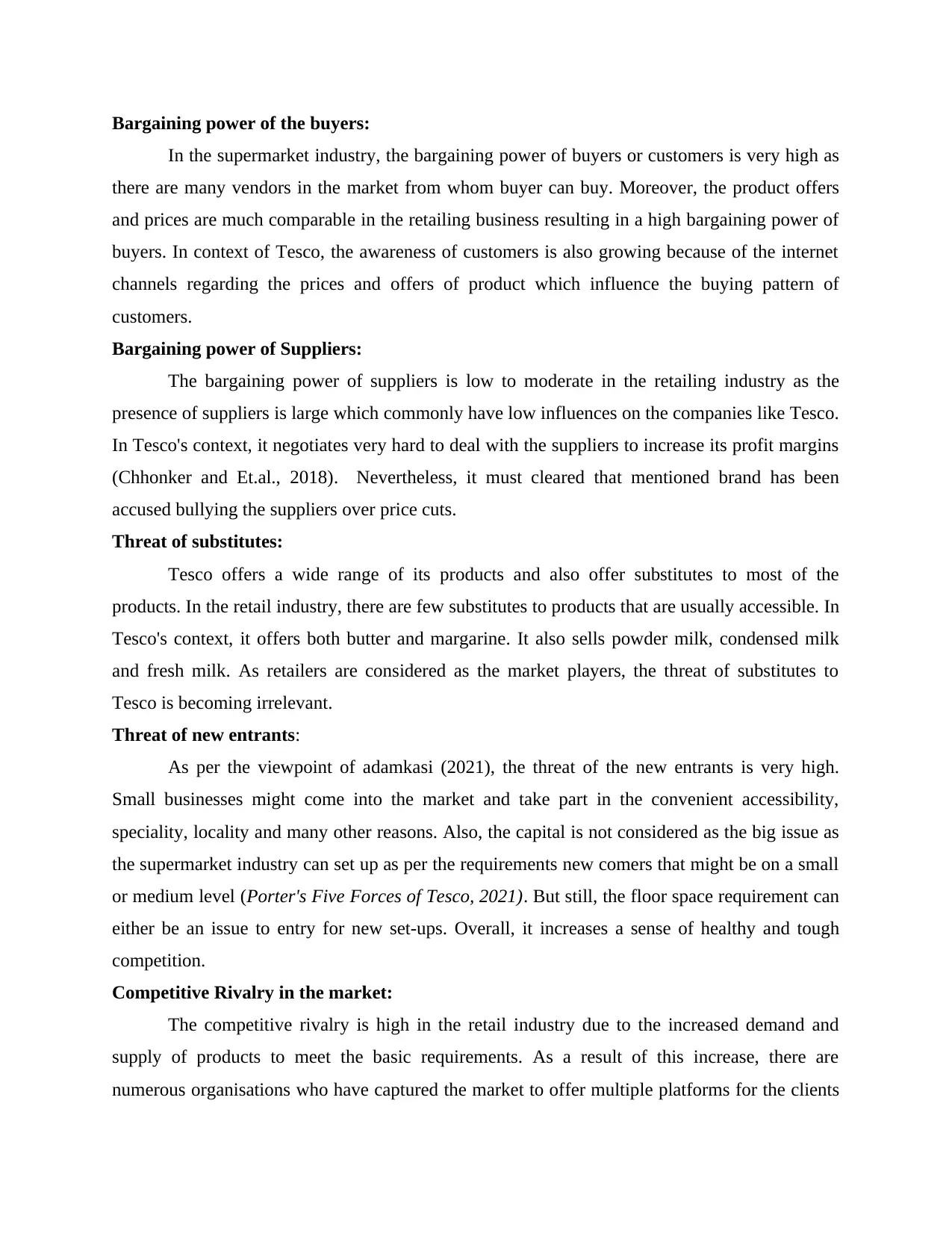
Bargaining power of the buyers:
In the supermarket industry, the bargaining power of buyers or customers is very high as
there are many vendors in the market from whom buyer can buy. Moreover, the product offers
and prices are much comparable in the retailing business resulting in a high bargaining power of
buyers. In context of Tesco, the awareness of customers is also growing because of the internet
channels regarding the prices and offers of product which influence the buying pattern of
customers.
Bargaining power of Suppliers:
The bargaining power of suppliers is low to moderate in the retailing industry as the
presence of suppliers is large which commonly have low influences on the companies like Tesco.
In Tesco's context, it negotiates very hard to deal with the suppliers to increase its profit margins
(Chhonker and Et.al., 2018). Nevertheless, it must cleared that mentioned brand has been
accused bullying the suppliers over price cuts.
Threat of substitutes:
Tesco offers a wide range of its products and also offer substitutes to most of the
products. In the retail industry, there are few substitutes to products that are usually accessible. In
Tesco's context, it offers both butter and margarine. It also sells powder milk, condensed milk
and fresh milk. As retailers are considered as the market players, the threat of substitutes to
Tesco is becoming irrelevant.
Threat of new entrants:
As per the viewpoint of adamkasi (2021), the threat of the new entrants is very high.
Small businesses might come into the market and take part in the convenient accessibility,
speciality, locality and many other reasons. Also, the capital is not considered as the big issue as
the supermarket industry can set up as per the requirements new comers that might be on a small
or medium level (Porter's Five Forces of Tesco, 2021). But still, the floor space requirement can
either be an issue to entry for new set-ups. Overall, it increases a sense of healthy and tough
competition.
Competitive Rivalry in the market:
The competitive rivalry is high in the retail industry due to the increased demand and
supply of products to meet the basic requirements. As a result of this increase, there are
numerous organisations who have captured the market to offer multiple platforms for the clients
In the supermarket industry, the bargaining power of buyers or customers is very high as
there are many vendors in the market from whom buyer can buy. Moreover, the product offers
and prices are much comparable in the retailing business resulting in a high bargaining power of
buyers. In context of Tesco, the awareness of customers is also growing because of the internet
channels regarding the prices and offers of product which influence the buying pattern of
customers.
Bargaining power of Suppliers:
The bargaining power of suppliers is low to moderate in the retailing industry as the
presence of suppliers is large which commonly have low influences on the companies like Tesco.
In Tesco's context, it negotiates very hard to deal with the suppliers to increase its profit margins
(Chhonker and Et.al., 2018). Nevertheless, it must cleared that mentioned brand has been
accused bullying the suppliers over price cuts.
Threat of substitutes:
Tesco offers a wide range of its products and also offer substitutes to most of the
products. In the retail industry, there are few substitutes to products that are usually accessible. In
Tesco's context, it offers both butter and margarine. It also sells powder milk, condensed milk
and fresh milk. As retailers are considered as the market players, the threat of substitutes to
Tesco is becoming irrelevant.
Threat of new entrants:
As per the viewpoint of adamkasi (2021), the threat of the new entrants is very high.
Small businesses might come into the market and take part in the convenient accessibility,
speciality, locality and many other reasons. Also, the capital is not considered as the big issue as
the supermarket industry can set up as per the requirements new comers that might be on a small
or medium level (Porter's Five Forces of Tesco, 2021). But still, the floor space requirement can
either be an issue to entry for new set-ups. Overall, it increases a sense of healthy and tough
competition.
Competitive Rivalry in the market:
The competitive rivalry is high in the retail industry due to the increased demand and
supply of products to meet the basic requirements. As a result of this increase, there are
numerous organisations who have captured the market to offer multiple platforms for the clients
⊘ This is a preview!⊘
Do you want full access?
Subscribe today to unlock all pages.

Trusted by 1+ million students worldwide
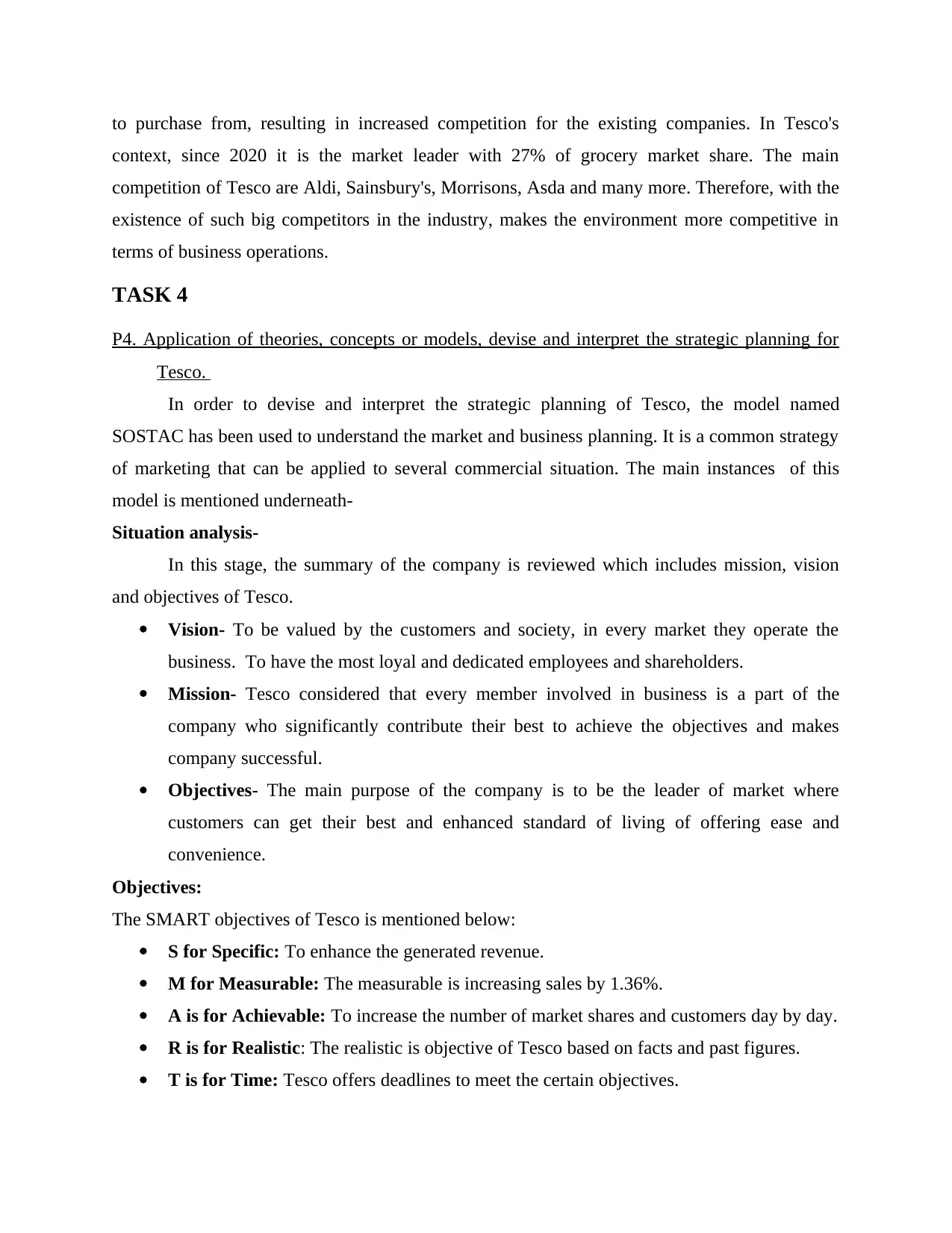
to purchase from, resulting in increased competition for the existing companies. In Tesco's
context, since 2020 it is the market leader with 27% of grocery market share. The main
competition of Tesco are Aldi, Sainsbury's, Morrisons, Asda and many more. Therefore, with the
existence of such big competitors in the industry, makes the environment more competitive in
terms of business operations.
TASK 4
P4. Application of theories, concepts or models, devise and interpret the strategic planning for
Tesco.
In order to devise and interpret the strategic planning of Tesco, the model named
SOSTAC has been used to understand the market and business planning. It is a common strategy
of marketing that can be applied to several commercial situation. The main instances of this
model is mentioned underneath-
Situation analysis-
In this stage, the summary of the company is reviewed which includes mission, vision
and objectives of Tesco.
Vision- To be valued by the customers and society, in every market they operate the
business. To have the most loyal and dedicated employees and shareholders.
Mission- Tesco considered that every member involved in business is a part of the
company who significantly contribute their best to achieve the objectives and makes
company successful.
Objectives- The main purpose of the company is to be the leader of market where
customers can get their best and enhanced standard of living of offering ease and
convenience.
Objectives:
The SMART objectives of Tesco is mentioned below:
S for Specific: To enhance the generated revenue.
M for Measurable: The measurable is increasing sales by 1.36%.
A is for Achievable: To increase the number of market shares and customers day by day.
R is for Realistic: The realistic is objective of Tesco based on facts and past figures.
T is for Time: Tesco offers deadlines to meet the certain objectives.
context, since 2020 it is the market leader with 27% of grocery market share. The main
competition of Tesco are Aldi, Sainsbury's, Morrisons, Asda and many more. Therefore, with the
existence of such big competitors in the industry, makes the environment more competitive in
terms of business operations.
TASK 4
P4. Application of theories, concepts or models, devise and interpret the strategic planning for
Tesco.
In order to devise and interpret the strategic planning of Tesco, the model named
SOSTAC has been used to understand the market and business planning. It is a common strategy
of marketing that can be applied to several commercial situation. The main instances of this
model is mentioned underneath-
Situation analysis-
In this stage, the summary of the company is reviewed which includes mission, vision
and objectives of Tesco.
Vision- To be valued by the customers and society, in every market they operate the
business. To have the most loyal and dedicated employees and shareholders.
Mission- Tesco considered that every member involved in business is a part of the
company who significantly contribute their best to achieve the objectives and makes
company successful.
Objectives- The main purpose of the company is to be the leader of market where
customers can get their best and enhanced standard of living of offering ease and
convenience.
Objectives:
The SMART objectives of Tesco is mentioned below:
S for Specific: To enhance the generated revenue.
M for Measurable: The measurable is increasing sales by 1.36%.
A is for Achievable: To increase the number of market shares and customers day by day.
R is for Realistic: The realistic is objective of Tesco based on facts and past figures.
T is for Time: Tesco offers deadlines to meet the certain objectives.
Paraphrase This Document
Need a fresh take? Get an instant paraphrase of this document with our AI Paraphraser
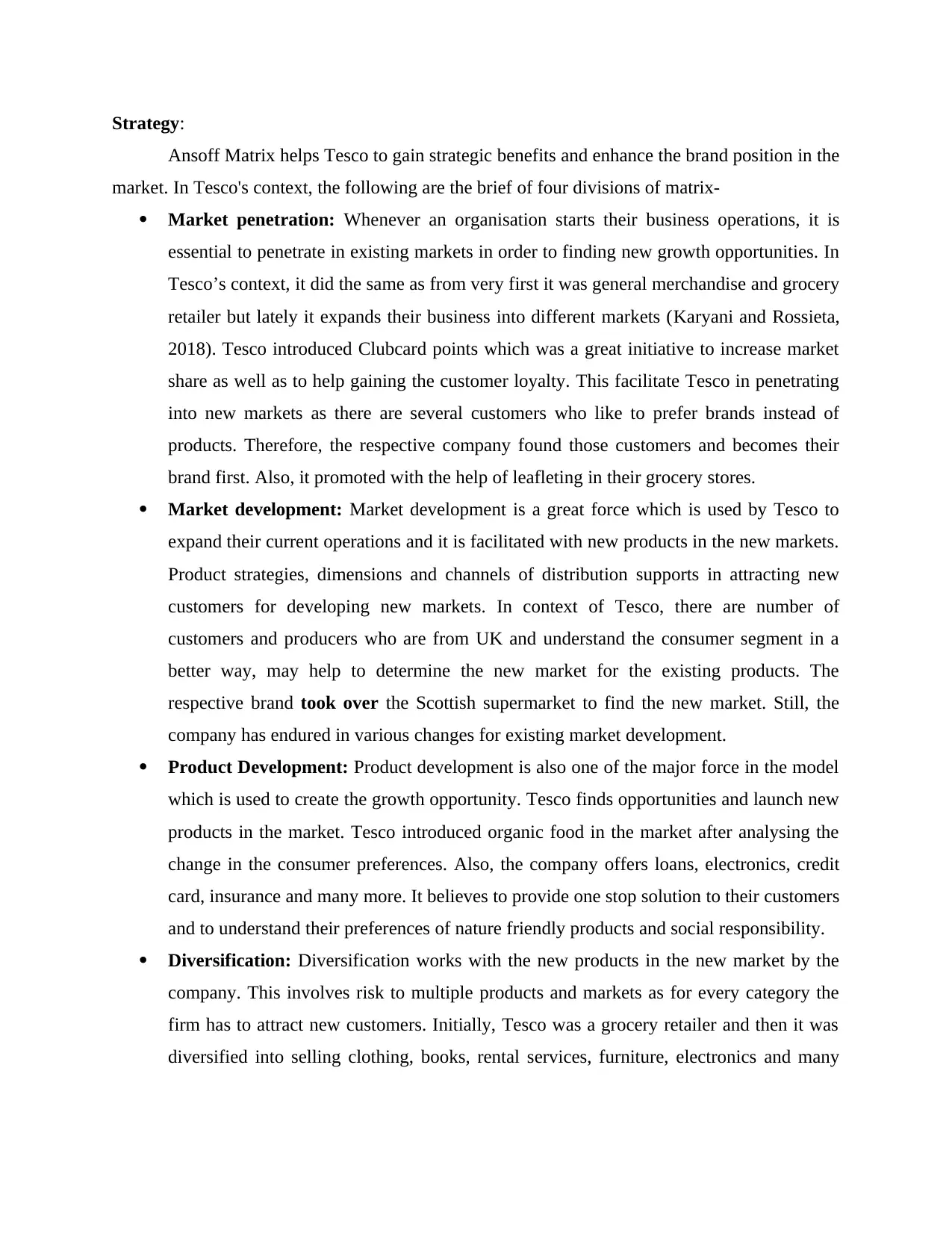
Strategy:
Ansoff Matrix helps Tesco to gain strategic benefits and enhance the brand position in the
market. In Tesco's context, the following are the brief of four divisions of matrix-
Market penetration: Whenever an organisation starts their business operations, it is
essential to penetrate in existing markets in order to finding new growth opportunities. In
Tesco’s context, it did the same as from very first it was general merchandise and grocery
retailer but lately it expands their business into different markets (Karyani and Rossieta,
2018). Tesco introduced Clubcard points which was a great initiative to increase market
share as well as to help gaining the customer loyalty. This facilitate Tesco in penetrating
into new markets as there are several customers who like to prefer brands instead of
products. Therefore, the respective company found those customers and becomes their
brand first. Also, it promoted with the help of leafleting in their grocery stores.
Market development: Market development is a great force which is used by Tesco to
expand their current operations and it is facilitated with new products in the new markets.
Product strategies, dimensions and channels of distribution supports in attracting new
customers for developing new markets. In context of Tesco, there are number of
customers and producers who are from UK and understand the consumer segment in a
better way, may help to determine the new market for the existing products. The
respective brand took over the Scottish supermarket to find the new market. Still, the
company has endured in various changes for existing market development.
Product Development: Product development is also one of the major force in the model
which is used to create the growth opportunity. Tesco finds opportunities and launch new
products in the market. Tesco introduced organic food in the market after analysing the
change in the consumer preferences. Also, the company offers loans, electronics, credit
card, insurance and many more. It believes to provide one stop solution to their customers
and to understand their preferences of nature friendly products and social responsibility.
Diversification: Diversification works with the new products in the new market by the
company. This involves risk to multiple products and markets as for every category the
firm has to attract new customers. Initially, Tesco was a grocery retailer and then it was
diversified into selling clothing, books, rental services, furniture, electronics and many
Ansoff Matrix helps Tesco to gain strategic benefits and enhance the brand position in the
market. In Tesco's context, the following are the brief of four divisions of matrix-
Market penetration: Whenever an organisation starts their business operations, it is
essential to penetrate in existing markets in order to finding new growth opportunities. In
Tesco’s context, it did the same as from very first it was general merchandise and grocery
retailer but lately it expands their business into different markets (Karyani and Rossieta,
2018). Tesco introduced Clubcard points which was a great initiative to increase market
share as well as to help gaining the customer loyalty. This facilitate Tesco in penetrating
into new markets as there are several customers who like to prefer brands instead of
products. Therefore, the respective company found those customers and becomes their
brand first. Also, it promoted with the help of leafleting in their grocery stores.
Market development: Market development is a great force which is used by Tesco to
expand their current operations and it is facilitated with new products in the new markets.
Product strategies, dimensions and channels of distribution supports in attracting new
customers for developing new markets. In context of Tesco, there are number of
customers and producers who are from UK and understand the consumer segment in a
better way, may help to determine the new market for the existing products. The
respective brand took over the Scottish supermarket to find the new market. Still, the
company has endured in various changes for existing market development.
Product Development: Product development is also one of the major force in the model
which is used to create the growth opportunity. Tesco finds opportunities and launch new
products in the market. Tesco introduced organic food in the market after analysing the
change in the consumer preferences. Also, the company offers loans, electronics, credit
card, insurance and many more. It believes to provide one stop solution to their customers
and to understand their preferences of nature friendly products and social responsibility.
Diversification: Diversification works with the new products in the new market by the
company. This involves risk to multiple products and markets as for every category the
firm has to attract new customers. Initially, Tesco was a grocery retailer and then it was
diversified into selling clothing, books, rental services, furniture, electronics and many
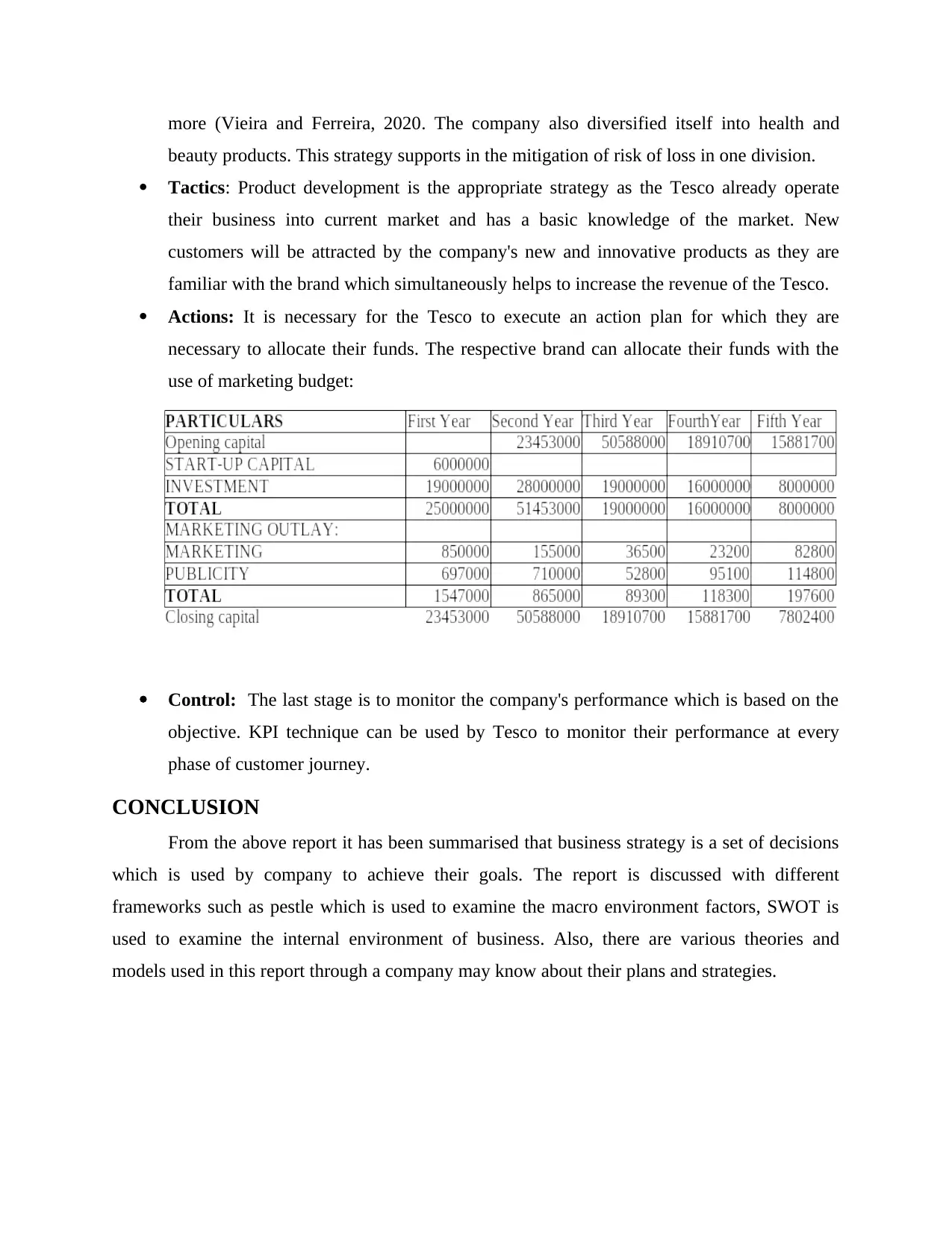
more (Vieira and Ferreira, 2020. The company also diversified itself into health and
beauty products. This strategy supports in the mitigation of risk of loss in one division.
Tactics: Product development is the appropriate strategy as the Tesco already operate
their business into current market and has a basic knowledge of the market. New
customers will be attracted by the company's new and innovative products as they are
familiar with the brand which simultaneously helps to increase the revenue of the Tesco.
Actions: It is necessary for the Tesco to execute an action plan for which they are
necessary to allocate their funds. The respective brand can allocate their funds with the
use of marketing budget:
Control: The last stage is to monitor the company's performance which is based on the
objective. KPI technique can be used by Tesco to monitor their performance at every
phase of customer journey.
CONCLUSION
From the above report it has been summarised that business strategy is a set of decisions
which is used by company to achieve their goals. The report is discussed with different
frameworks such as pestle which is used to examine the macro environment factors, SWOT is
used to examine the internal environment of business. Also, there are various theories and
models used in this report through a company may know about their plans and strategies.
beauty products. This strategy supports in the mitigation of risk of loss in one division.
Tactics: Product development is the appropriate strategy as the Tesco already operate
their business into current market and has a basic knowledge of the market. New
customers will be attracted by the company's new and innovative products as they are
familiar with the brand which simultaneously helps to increase the revenue of the Tesco.
Actions: It is necessary for the Tesco to execute an action plan for which they are
necessary to allocate their funds. The respective brand can allocate their funds with the
use of marketing budget:
Control: The last stage is to monitor the company's performance which is based on the
objective. KPI technique can be used by Tesco to monitor their performance at every
phase of customer journey.
CONCLUSION
From the above report it has been summarised that business strategy is a set of decisions
which is used by company to achieve their goals. The report is discussed with different
frameworks such as pestle which is used to examine the macro environment factors, SWOT is
used to examine the internal environment of business. Also, there are various theories and
models used in this report through a company may know about their plans and strategies.
⊘ This is a preview!⊘
Do you want full access?
Subscribe today to unlock all pages.

Trusted by 1+ million students worldwide
1 out of 15
Related Documents
Your All-in-One AI-Powered Toolkit for Academic Success.
+13062052269
info@desklib.com
Available 24*7 on WhatsApp / Email
![[object Object]](/_next/static/media/star-bottom.7253800d.svg)
Unlock your academic potential
Copyright © 2020–2025 A2Z Services. All Rights Reserved. Developed and managed by ZUCOL.




